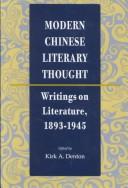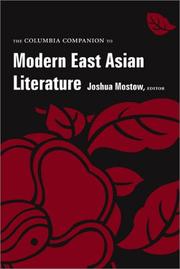| Listing 1 - 10 of 19 | << page >> |
Sort by
|
Book
ISBN: 8024635399 9788024635392 9788024635132 8024635135 Year: 2016 Publisher: Prague
Abstract | Keywords | Export | Availability | Bookmark
 Loading...
Loading...Choose an application
- Reference Manager
- EndNote
- RefWorks (Direct export to RefWorks)
Kniha "Crossing Between Tradition and Modernity" představuje soubor třinácti esejů k uctění památky Mileny Doleželové-Velingerové (1932-2012), členky pražské sinologické školy a významné odbornice na čínskou literaturu, která zastávala přední místo při zavádění literární teorie a její důsledné aplikace v sinologii. Milena Doleželová-Velingerová byla jedním z těch vzácných vědeckých pracovníků, kteří psali se stejnou erudicí a stejně kvalifikovaně jak o moderní, tak i o klasické literatuře. Eseje následují příkladu Mileny Doleželové-Velingerové v tom smyslu, že se zabývají širokým spektrem historických období, literárních žánrů a témat - od Tangových cestovatelských esejů až po kulturní identitu postkoloniálního Hong-Kongu. Eseje jsou strukturovány do dvou částí Language, Structure, and Genre a Identities and Self-Representations. Jsou motivovány soustředěným zájmem o problematiku jazyka, narativní struktury a komplexní povahy literárního významu, tématy, které byly středobodem práce Mileny Doleželové-Velingerové.
Book
ISBN: 9780824840068 0824840062 9780824869748 0824869745 0824836871 Year: 2013 Publisher: Honolulu
Abstract | Keywords | Export | Availability | Bookmark
 Loading...
Loading...Choose an application
- Reference Manager
- EndNote
- RefWorks (Direct export to RefWorks)
During the Mao era, China's museums served an explicit and uniform propaganda function, underlining official Party history, eulogizing revolutionary heroes, and contributing to nation building and socialist construction. With the implementation of the post-Mao modernization program in the late 1970s and 1980s and the advent of globalization and market reforms in the 1990s, China underwent a radical social and economic transformation that has led to a vastly more heterogeneous culture and polity. Yet China is dominated by a single Leninist party that continues to rely heavily on its revolutionary heritage to generate political legitimacy. With its messages of collectivism, self-sacrifice, and class struggle, that heritage is increasingly at odds with Chinese society and with the state's own neoliberal ideology of rapid-paced development, glorification of the market, and entrepreneurship. In this ambiguous political environment, museums and their curators must negotiate between revolutionary ideology and new kinds of historical narratives that reflect and highlight a neoliberal present. In Exhibiting the Past, Kirk Denton analyzes types of museums and exhibitionary spaces, from revolutionary history museums, military museums, and memorials to martyrs to museums dedicated to literature, ethnic minorities, and local history. He discusses red tourism-a state sponsored program developed in 2003 as a new form of patriotic education designed to make revolutionary history come alive-and urban planning exhibition halls, which project utopian visions of China's future that are rooted in new conceptions of the past. Denton's method is narratological in the sense that he analyzes the stories museums tell about the past and the political and ideological implications of those stories. Focusing on "official" exhibitionary culture rather than alternative or counter memory, Denton reinserts the state back into the discussion of postsocialist culture because of its centrality to that culture and to show that state discourse in China is neither monolithic nor unchanging. The book considers the variety of ways state museums are responding to the dramatic social, technological, and cultural changes China has experienced over the past three decades.
Collective memory --- Museums --- Collective remembrance --- Common memory --- Cultural memory --- Emblematic memory --- Historical memory --- National memory --- Public memory --- Social memory --- Memory --- Social psychology --- Group identity --- National characteristics --- Public institutions --- Cabinets of curiosities --- Government policy --- Political aspects

ISBN: 0804725594 Year: 1995 Publisher: Stanford (Calif.): Stanford university press
Abstract | Keywords | Export | Availability | Bookmark
 Loading...
Loading...Choose an application
- Reference Manager
- EndNote
- RefWorks (Direct export to RefWorks)
Chinese literature --- History and criticism --- Theory, etc
Book
ISBN: 9780824836870 Year: 2014 Publisher: Honolulu University of Hawaiʻi Press
Abstract | Keywords | Export | Availability | Bookmark
 Loading...
Loading...Choose an application
- Reference Manager
- EndNote
- RefWorks (Direct export to RefWorks)
A study of museums, and their representation of history, in post-Mao China.
Collective memory --- Museums --- Government policy --- Political aspects
Book
ISBN: 9888528904 9789888528905 9888528572 9789888528578 Year: 2021 Publisher: Hong Kong : Hong Kong Univ. P.,
Abstract | Keywords | Export | Availability | Bookmark
 Loading...
Loading...Choose an application
- Reference Manager
- EndNote
- RefWorks (Direct export to RefWorks)
'The Landscape of Historical Memory' explores the place of museums and memorial culture in the contestation over historical memory in post-martial law Taiwan. The book is particularly oriented toward the role of politics, especially political parties, in the establishment, administration, architectural design, and historical narratives of museums. It is framed around the wrangling between the 'blue camp' (the Nationalist Party, or KMT, and its supporters) and the 'green camp' (Democratic Progressive Party, or DPP, and its supporters) over what facets of the past should be remembered and how they should be displayed in museums.
Book
ISBN: 9789888528578 9888528572 Year: 2021 Publisher: Hong Kong Hong Kong University Press
Abstract | Keywords | Export | Availability | Bookmark
 Loading...
Loading...Choose an application
- Reference Manager
- EndNote
- RefWorks (Direct export to RefWorks)
Multi
ISBN: 9780824840068 9780824836870 Year: 2013 Publisher: Honolulu, Hawaii University of Hawaii Press
Abstract | Keywords | Export | Availability | Bookmark
 Loading...
Loading...Choose an application
- Reference Manager
- EndNote
- RefWorks (Direct export to RefWorks)
A study of museums, and their representation of history, in post-Mao China.
History --- Collective memory --- Museums --- Government policy --- Political aspects
Book
ISBN: 0674981456 0674981448 Year: 2017 Publisher: Cambridge, MA : Harvard University Press,
Abstract | Keywords | Export | Availability | Bookmark
 Loading...
Loading...Choose an application
- Reference Manager
- EndNote
- RefWorks (Direct export to RefWorks)
Lu Xun (1881-1936) is widely considered the greatest writer of twentieth-century China. Although primarily known for his two slim volumes of short fiction, he was a prolific, inventive essayist. These 62 essays-20 translated for the first time-showcase his versatility as a master of prose forms and his brilliance as a cultural critic.
Lu, Xun --- Lu, Xun. --- Lu, Xun, --- China --- Civilization --- Social life and customs
Multi
ISBN: 9780674981447 9780674744257 0674981448 067474425X Year: 2017 Publisher: Cambridge, Massachusetts
Abstract | Keywords | Export | Availability | Bookmark
 Loading...
Loading...Choose an application
- Reference Manager
- EndNote
- RefWorks (Direct export to RefWorks)

ISBN: 0231113145 0231507364 0585473218 Year: 2003 Publisher: New York : Columbia University Press,
Abstract | Keywords | Export | Availability | Bookmark
 Loading...
Loading...Choose an application
- Reference Manager
- EndNote
- RefWorks (Direct export to RefWorks)
This extraordinary one-volume guide to the modern literatures of China, Japan, and Korea is the definitive reference work on the subject in the English language. With more than one hundred articles that show how a host of authors and literary movements have contributed to the general literary development of their respective countries, this companion is an essential starting point for the study of East Asian literatures. Comprehensive thematic essays introduce each geographical section with historical overviews and surveys of persistent themes in the literature examined, including nationalism, gender, family relations, and sexuality. Following the thematic essays are the individual entries: over forty for China, over fifty for Japan, and almost thirty for Korea, featuring everything from detailed analyses of the works of Tanizaki Jun'ichiro and Murakami Haruki, to far-ranging explorations of avant-garde fiction in China and postwar novels in Korea. Arrayed chronologically, each entry is self-contained, though extensive cross-referencing affords readers the opportunity to gain a more synoptic view of the work, author, or movement. The unrivaled opportunities for comparative analysis alone make this unique companion an indispensable reference for anyone interested in the burgeoning field of Asian literature. Although the literatures of China, Japan, and Korea are each allotted separate sections, the editors constantly kept an eye open to those writers, works, and movements that transcend national boundaries. This includes, for example, Chinese authors who lived and wrote in Japan; Japanese authors who wrote in classical Chinese; and Korean authors who write in Japanese, whether under the colonial occupation or because they are resident in Japan. The waves of modernization can be seen as reaching each of these countries in a staggered fashion, with eddies and back-flows between them then complicating the picture further. This volume provides a vivid sense of this dynamic interplay.
East Asian literature --- Oriental literature --- Asian literature --- Asia --- Study and teaching.
| Listing 1 - 10 of 19 | << page >> |
Sort by
|

 Search
Search Feedback
Feedback About UniCat
About UniCat  Help
Help News
News